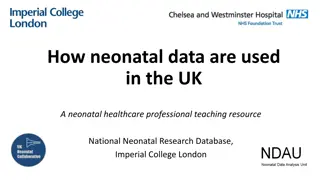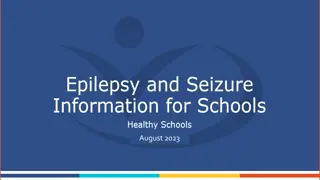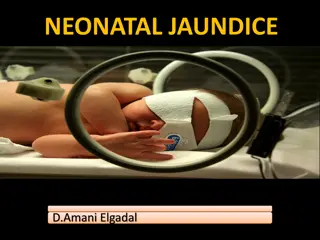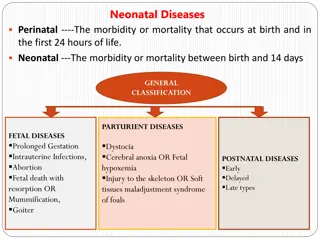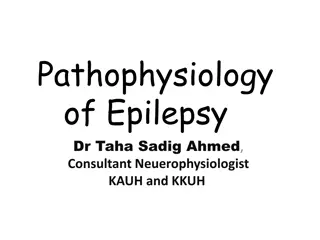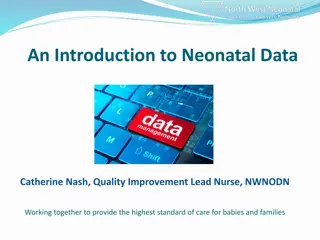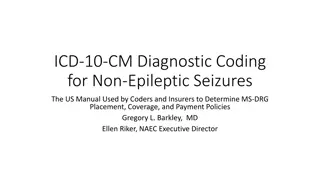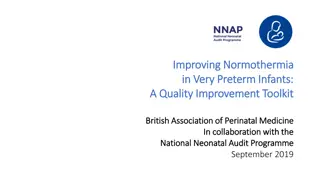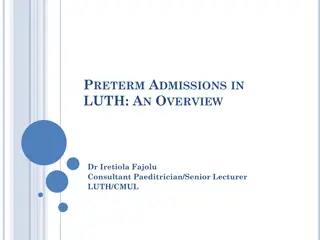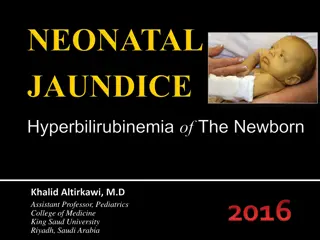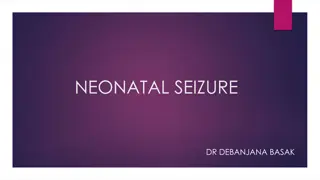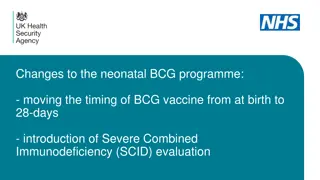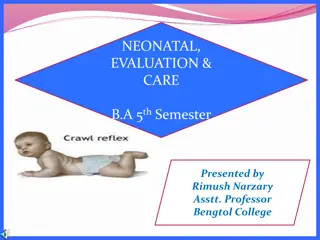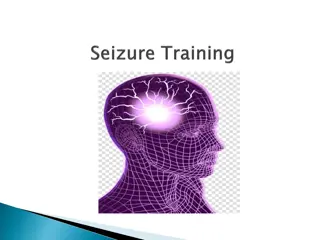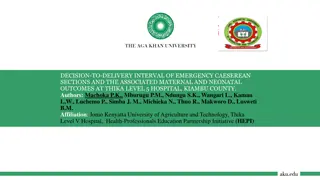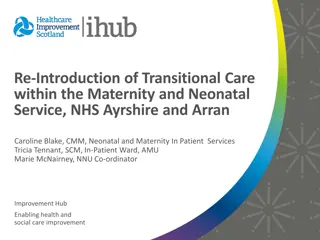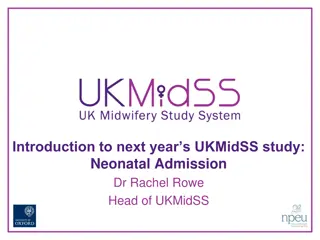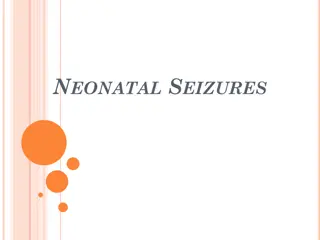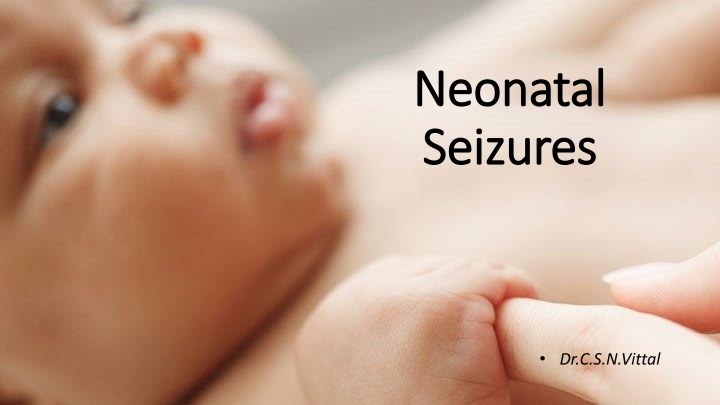
Neonatal Seizures
Explore the definitions, pathophysiology, and various causes of neonatal seizures as detailed by Dr. C.S. N. Vittal. Learn about the paroxysmal alterations in neurologic function in newborns and the factors contributing to hypersynchronous discharge of neurons, including immature brain development and specific conditions like hypoglycemia, infections, and metabolic disorders.
Download Presentation

Please find below an Image/Link to download the presentation.
The content on the website is provided AS IS for your information and personal use only. It may not be sold, licensed, or shared on other websites without obtaining consent from the author. If you encounter any issues during the download, it is possible that the publisher has removed the file from their server.
You are allowed to download the files provided on this website for personal or commercial use, subject to the condition that they are used lawfully. All files are the property of their respective owners.
The content on the website is provided AS IS for your information and personal use only. It may not be sold, licensed, or shared on other websites without obtaining consent from the author.
E N D
Presentation Transcript
Neonatal Neonatal Seizures Seizures Dr.C.S.N.Vittal
DEFINITIONS SEIZURE: A seizure is a paroxysmal behavior caused by hypersynchronous discharge of a group of neurons. NEONATAL SEIZURE: Neonatal seizures may be defined more aptly as paroxysmal alterations in neurologic function (eg, behavioral, motor, or autonomic function). Neonatal seizures are the most common overt manifestation of neurological dysfunction in the newborn.
Pathophysiology Pathophysiology Immature brain has many differences from the mature brain that render it more excitable and more likely to develop seizures. Delay in Na+ , K+ -adenosine triphosphatase maturation and increased NMDA and -amino-3-hydroxy-5-methylisoxazole-4- propionate (AMPA) receptor density. Delay in the development of inhibitory GABAergic transmission GABA in the immature brain has an excitatory function
CAUSES OF NEONATAL SEIZURES CAUSES OF NEONATAL SEIZURES Presentation Time < 4 days Aetiology of Seizures Hypoxic-ischaemic encephalopathy Acute metabolic disorders Intra cranial haemorrhage Acute metabolic disorders Hypoglycemia, Hypoelectrolytemia Congenital Viral infections Pyridoxine dependency Non-ketotic Hyperglycemia Urea cycle disorder Sepsis
CAUSES OF NEONATAL SEIZURES CAUSES OF NEONATAL SEIZURES Presentation Time 4-14 days Aetiology of Seizures Infection Meningitis (bacterial) Encephalitis (enteroviral, herpes simplex) Metabolic disorders Hypocalcemia related to diet, milk formula Hypoglycemia, persistent Inherited disorders of metabolism Galactosemia, Fructosemia Drug withdrawal : Eg. Methadone Kernicterus
CAUSES OF NEONATAL SEIZURES CAUSES OF NEONATAL SEIZURES Presentation Time 2-8 weeks Aetiology of Seizures Infection Herpes simplex or enteroviral encephalitis Bacterial meningitis Head injury Subdural hematoma Child abuse Inherited disorders of metabolism Aminoacidurias Urea cycle defects Organic acidurias Malformations of cortical development
Etiology Etiology HIE (35 - 45%) Infarction & Hemorrhage (20-30%) Brain Malformations (5-10%) Infections (5-20%) Metabolic (7-20%) Genetic (6-10%) Hypoxic-Ischemic Encephalopathy Unknown/ Other (10%) Infections Brain Malformations Metabolic Genetic Infarction & Hemorrhage
Neonatal Seizures - Types 01 Subtle 02 Clonic 03 Tonic 04 Spasms 05 Myoclonic
01 1 Subtle Seizures 1 Subtle Seizures Transient eye deviations, nystagmus, blinking, mouthing, Abnormal extremity movements (rowing, swimming, bicycling, pedalling, and Stepping), Fluctuations in heart rate, hypertension episodes, and Apnea. More commonly in premature
02 2 2 Clonic Clonic Seizures Seizures Focal: Involve face upper + /- lower extremities on one site axial structures (neck / trunk) Usually associated with neuropathology (i.e. Cerebral infarction and intra cerebral haemorrhage) Multi focal: Involve several body parts and often migrate in a non-jacksonian (random) manner may also involve the face. Consider the neonatal equivalent of generalized tonic clonic seizures.
03 3 3 Tonic Seizures Tonic Seizures Focal Sustained posturing of a limb or Asymmetric posturing of the trunk and / or neck Generalized : Decerebrate posturing Decorticate posturing Usually associated with apnoea and upward gaze of eyes Most common in preemies and usually indicates structural brain damage and IVH :
04 4 Spasms 4 Spasms Spasms are sudden generalized jerks lasting 1-2 sec May be flexor or extensor or mixed Shorter duration Cannot be provoked by stimulation or suppressed by restraint Usually associated with a single, very brief, generalized discharge Epileptic in nature
05 5 Myoclonic seizures 5 Myoclonic seizures Characteristics: Rapidity of the jerks (<50 msec) and by their lack of rhythmicity Focal : Mostly flexors of upper limbs Multifocal: Asynchronous twitching of several parts of body. Generalized: Bilateral jerks of upper and some times lower limbs Rapid movements of distal flexors All 3 types of may occur during sleep in the new born. Presence suggests severe diffuse brain damage
Differentiation of Seizures from Nonconvulsive Movements Differentiation of Seizures from Nonconvulsive Movements Jitteriness Tremor No associated ocular movements or autonomic phenomena, Stimulus sensitivity, Tremor that is suppressed by flexing the limb. Benign neonatal sleep myoclonus Occurs in healthy newborns Only during sleep. Jerking ceases on wakening Apnea of prematurity In Preterms, apnea and bradycardia
Diagnosis Diagnosis - History: Maternal drug abuse, Intrauterine infection, metabolic disease, natal history, etc. - Complete Hemogram - Blood : Sugar, Calcium, Magnesium, Na+, K+ & HCO3 , Elevated Ammonia, Lactate Levels, Culture & Sensitivity, plasma aminoacids, drugs - CSF :Analysis, Biochemical & C/s. - Cranial U/s. : hemorrhage, cysts, abnormal ventricles - EEG :Plays an important role
Diagnosis Diagnosis - - EEG EEG Continuous electroencephalogram (cEEG): >3 hours of monitoring is gold standard for the diagnosis of neonatal seizures Including video analysis can be very helpful Routine neonatal EEG recording, typically of 1 hour duration, allows assessment of background activity, including cycling state change, developmental maturity, and sometimes, epileptic potential. Amplitude-integrated electroencephalogram (aiEEG): a bedside technique increasingly being used by neonatologists for neuromonitoring
MANAGEMENT OF NEONATAL SEIZURES MANAGEMENT OF NEONATAL SEIZURES - - ACUTE PHASE ACUTE PHASE Aim: prevent brain injury GENERAL MEASURES : OPTIMISE:Ventilation, Circulation, Electrolytes, Acid-Base Balance NONEPILEPTIC EVENTS : Associated with No EEG Seizure Activity. These Types of Neonatal Seizures Should not be Treated. EPILEPTIC EVENTS: Associated with EEG Seizure Activity
MANAGEMENT: - Correct metabolic disturbances. Correct metabolic disturbances. Hypoglycemia: (10% glucose in water) 2 mL/kg IV (0.2 g/kg) as bolus . Follow with continuous infusion at up to 8 mg/kg/min IV
MANAGEMENT: - Correct metabolic disturbances. Correct metabolic disturbances. Hypocalcemia: Calcium gluconate 10%: 100 mg/kg IV mixed with equal amount of 10% dextrose given by slow I.V. over 1 to 3 minutes Note: Monitor cardiac rhythm for bradycardia Follow with maintenance of 500 mg/kg/24 hrs IV or PO Hypomagnesemia: Magnesium sulfate - 25-250 mg/kg/dose IV/IM (50% magnesium sulphate 0.2 ml/kg)
Management Management: - Anticonvulsant therapy. Anticonvulsant therapy. 1.Phenobarbital: 20 mg/kg IV. If necessary, additional 10-20 mg/kg IV in 10 mg/kg aliquots Maintenance: 4 6 mg/kg/24 hrs IV/PO If 40 mg/kg of Phenobarbital is not effective, >> 2. Lorazepam: 0.05 mg/kg to 0.10 mg/kg IV in 0.05 mg/kg increments over several minutes. (Inj. Clonzepam Loading dose of 0.25 mg/kg followed by 0.01 to 0.03 mg/kg/orally given (or) Inj. Midazolam 0.02 to 0.1 mg/kg - I.V. can be given ) 3. Phenytoin: 20 mg/kg IV (diluted in 0.9% NaCl) (Maximal rate: 1 mg/kg/min. Monitor cardiac rate and rhythm). Maintenance 5 10 mg/kg/24h IV 5. Fourth line anticonvulsants include Paraldehyde DIAZEPAM : Not safe in neonates as it interferes with vital functions its sedative effect half life exceeds 24 hours
Management of Pyridoxin Dependent Epilepsy Management of Pyridoxin Dependent Epilepsy Failure of conventional AEDs Pyridoxine 100 mg iv Caution: May cause severe hypotonia, bradycardia, apnea Treat with daily B6, 200 mg/ day B6 withdrawal challenge to confirm dx If seizure recur in 7 days to 3 weeks - restart B6
DURATION OF TREATMENT DURATION OF TREATMENT Determined by the underlying cause (i.e., related to risk of recurrence), the physical examination and the EEG When seizures have stopped and if the neurological examination is normal, consider stopping Phenobarbital. If the neurological examination remains abnormal, then consider stopping medication if the EEG is normal. Make this evaluation prior to discharge and then frequently after discharge, if the child has been discharged on Phenobarbital. Stop Phenytoin when IV therapy is stopped as this drug is very difficult to maintain PO.

